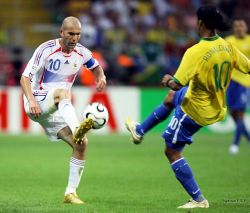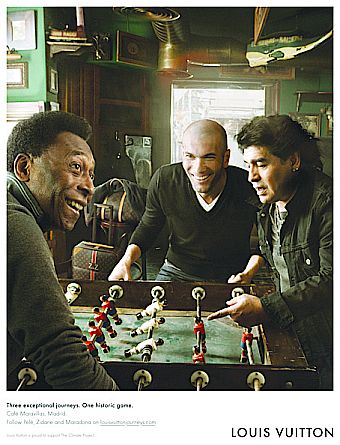
Louis Vuitton’s June 2010 magazine ad featuring soccer greats Pelé, Zidane and Maradona, photographed by Annie Leibovitz.
The setting for the photo shoot and the ad, shown at right, was the Café Maravillas, a typical bar in Madrid, Spain, where the three famous footballers are engaged in a spirited game of table-top foosball.
In the background of the ad are Louis Vuitton bags, one monogrammed with the initials “Z.Z.” for Zinedine Zidane. The tagline for the ad reads: “Three great journeys, one historic game.” Antoine Arnault, Vuitton’s media person at the time of the ad’s release, explained: “What true football fan has not dreamt of seeing these three living legends – Pelé, Maradona and Zidane – play each other?”
A series of the Vuitton ads with the famous soccer greats appeared in magazines and also online in the months leading up to the World Cup matches in June 2010, heading into the championship games in South Africa.
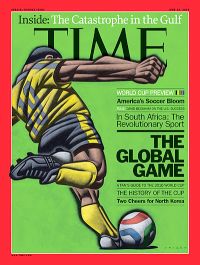
Vuitton’s “soccer legends” ad appear- ed on the back cover of Time’s June 2010 World Cup edition. Click for copy.
Louis Vuitton, for those who may not know, is a venerable fashion brand that began in 1894. Today it is a $2 billion company with 9,000 plus employees worldwide. The Vuitton label is well known for its “LV” monogram found on most of its products, which include luxury trunks and leather goods, shoes, watches, jewelry, accessories, sunglasses, and books. Vuitton is one of the world’s leading international fashion houses — and its ads in recent years have become well known for their celebrity and superstar subjects — Madonna, Jennifer Lopez, Gisele Bundchen, Bono, Sean Connery, and Mikhail Gorbachev among them. Other athletes, such as tennis stars Andre Agassi and Steffi Graf, have also appeared in Vuitton ads, but with the soccer stars, Vuitton was reaching for a broader and perhaps, more “everyman” audience.

Horizontal version of the Louis Vuitton “soccer greats” ad, also used for a related Louis Vuitton website campaign.
In addition to the magazine ads, Vuitton also had a dedicated website — louisvuittonjour- neys.com — where a featured conver- sation between the three players was included, in which they discussed their careers, recalled great matches they had played, and exchanged views on the world of soccer. Part of the story line at the website had Pelé and Zidane challenging each other to a match of table foosball. The ad, in any case, was likely a hit with soccer fans. What follows below are three brief profiles of each of the famous soccer legends.

French soccer star Zinedine Zidane is regarded as one of the best to have played World Cup soccer.
French soccer star Zinedine Zidane was born in 1972 to Algerian parents. He grew up in the modest suburbs of Marseilles after his parents left Algeria. Zidane played his first junior championship soccer at the age 14. Today, he is widely regarded as one of the greatest players in the history of World Cup soccer and has played for club teams in France, Italy and Spain. France won the World Cup in 1998 with a team full of immigrant players, with Zidane becoming an icon, especially among the poor. But French fans and players generally love him, not only for the 1998 World Cup but also the 2000 European Championship. He retired briefly thereafter, but soon returned to the French national team in 2005. He was captain of the French team in 2006, leading them in the World Cup Final where he won the Golden Ball as the tournament’s most outstanding player. Alongside Brazil’s soccer star, Ronaldo, Zidane is the only other three-time FIFA World Player of the Year winner. Zidane, however, had a bit of controversy toward the end of his career in a famous incident in which he head-butted Italy’s Marco Materazzi in chest during the 2006 World Cup Final in Berlin, and was thrown out of the game. Zidane maintained he was goaded by Materazzi, who had made a slur on Zidane’s sister, provoking Zidane’s action, which he later said was to defend “the honor of a Muslim woman.” Zidane, who had retired with that game, performed three days of community service to meet his penalty, while Materazzi later apologized publicly to Zidane for his slur. Although Zidane retired from professional football after the 2006 World Cup, he continued to play for the Real Madrid veterans team.
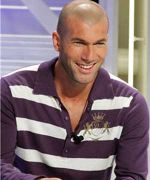
Zinedine Zidane.
In retirement, Zidane has also participated in charity soccer events in various countries around the world. In 2010 he was appointed as an ambassador for Qatar’s attempt to host the 2022 World Cup, a bid they won in December 2010. Zidane was also appointed as a special adviser to Real Madrid’s first team in 2010.
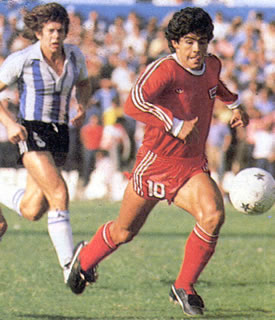
Diego Maradona as a young “juniors” player in 1980.
Diego Maradona, born in 1960, rose from the slums of Buenos Aires to become one of Argentina’s most famous and controversial soccer stars. He is widely regarded as one of the greatest football players of all time.
Over the course of his professional career Maradona set world-record contract fees for his soccer-playing abilities. Playing for Argentina he earned 91 caps and scored 34 goals. He played in four FIFA World Cup tournaments, including the 1986 tournament, in which he captained Argentina’s team and led them to their victory over West Germany in the final. He also won the Golden Ball award as the tournament’s best player.
In that tournament’s quarterfinal round, he scored two remarkable goals in a 2–1 victory over England, one of which has been described as a “spectacular 60-metre weave through six England players.” In Maradona lore this feat is also known by many as “The Goal of the Century”.
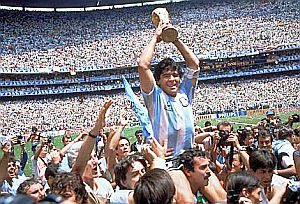
Diego Maradona bringing championship to Argentina.
“To understand the gargantuan shadow Maradona casts over his soccer-mad homeland, one has to conjure up the athleticism of Michael Jordan, the power of Babe Ruth — and the human fallibility of Mike Tyson. Lump them together in a single barrel-chested man with shaggy black hair and you have El Diego, idol to the millions who call him D10S, a mashup of his playing number and the Spanish word for God.”
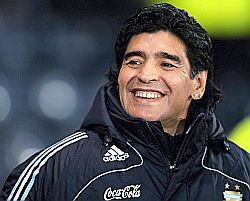
Maradona as photographed in recent years.
After retiring at age 37 in 1997, he increasingly suffered ill health, gained weight, and battled cocaine addiction. A 2005 stomach stapling operation helped control his weight and he overcame his cocaine addiction, becoming a popular TV host in Argentina. Although he had little previous managerial experience, he became head coach of the Argentina national soccer team in November 2008, remaining there through July 2010. In late October 2010, Puma, the athletic shoe and sports gear manufacturer, put on a major celebration for Maradona’s 50th birthday, also then introducing a new line of athletic wares in his name.
Pelé
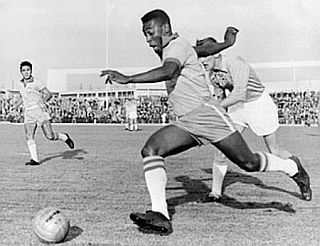
Pelé shown in action in 1958 World Cup soccer match.
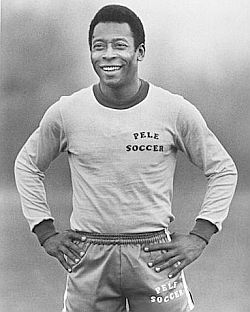
Pelé, Brazil’s soccer legend, shown in some “Pelé Soccer” garb.
In his career, Pelé scored 760 official goals, 541 in league championships, making him the top scorer of all time. In total during his career, he scored 1,281 goals in 1,363 games – 12 in World Cup final tournaments. During his playing years, he was known variously as “The King of Football,” “The King Pelé” or simply, “The King.” Pelé retired in 1974. However, in 1975, he came out of retirement to play in America for the New York Cosmos team of the new North American Soccer League (NASL). Pelé was paid a $1 million per year when he played for the Cosmos, and some attribute his playing there with helping generate interest in America to make the NASL a going concern. However, Pelé retired in 1977 after leading the Cosmos to the NASL championship.
Given his world soccer notoriety, Pelé became one the world’s most formidable marketing forces and something of an international brand. Prime Licensing, a company established by Pele’s friend and businessman, Jose Alves de Araujo, was set up to manage Pele’s various marketing deals. Prime Licensing managed a number of Pelé product endorsements and contracts, including those with Puma AG, Pelestation, QVC, and Fremantle Media, as well as Pelé brands Pelé L’uomo and Pelé Arena coffee houses. In recent years Pelé has earned an estimated $30 million a year from his businesses and endorsements. He has endorsed products from soccer balls, clothing, and equipment, to a Pelé soccer video game.

Pelé at work with famous “bicycle kick” in a September 1968 game between Brazil and Belgium in Rio de Janeiro. Associated Press photo. Click for wall print.
Even though he has been retired for more than three decades, the name Pelé is still synonymous with world-class soccer to millions around the world. And so, his appeal in advertising, especially running up to World Cup games in recent years, has made him one of the world’s top advertising personalities. During the 1994 World Cup, he was featured in a Master Card ad with an orchestra performing the song “America.” During the 2002 World Cup he earned millions doing ads for MasterCard, Pfizer, Petrobas, and Nokia. According to one account, leading up to that event, Pelé appeared in 20 million mailings, 100 World Cup promotions, and at least a dozen TV ads. Among other companies and brands he has represented around the world are: Time Warner, Procter & Gamble, Pizza Hut, Pepsi, and others. But Pelé has also given a part of himself to good causes, including ambassadorial work for various bodies. In the early 1990s, he was appointed a United Nations ambassador for ecology and the environment, and has continued working for good causes since then.
Vuitton’s Message

Pelé and Zidane at the photo shoot in Spain for the Louis Vuitton June 2010 ad.
Yet Zidane, Maradona, and Pelé have had their differences about the game – all in the spirit of good competition, of course. But in the Vuitton ads at least, it’s only camaraderie and friendly competition that are projected.

A monogrammed Louis Vuitton canvas bag from the ad showing initials “Z.Z.”
For additional stories at this website on advertising see the “Madison Avenue” category page. More sports stories can be found at the “Annals of Sport” page, or go to the Home page or Archive for additional choices. Thanks for visiting. – Jack Doyle
|
Please Support Thank You |
___________________________________
Date Posted: 26 January 2011
Last Update: 29 December 2022
Comments to: jdoyle@pophistorydig.com
Article Citation:
Jack Doyle, “Vuitton’s Soccer Stars, 2010,”
PopHistoryDig.com, January 26, 2011.
___________________________________
Sources, Links & Additional Information
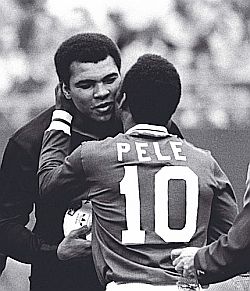 Pelé embracing boxer Muhammad Ali during ceremony honoring Pelé, then with NY Cosmos, at Giants Stadium, N.J., Oct 1, 1977. In final game, Pelé played a half on each side: Cosmos 2, Brazil Santos 1. |
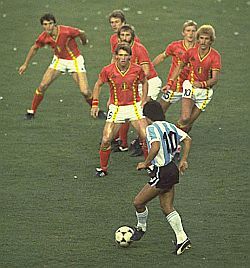 Argentina’s Maradona vs. Belgium, 1982. |
 In 1977, New York Cosmos players, from left, Chinaglia, Pele & Beckenbauer. |
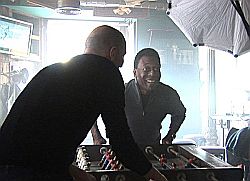 Zidane & Pelé in one of the photos from the Annie Leibovitz / Louis Vuitton shoot, 2010. |
Megan Baldwin, “It’s A Trend! Vuitton Taps Aging Soccer Stars For New Ads,” Styleite.com, April 23rd, 2010.
Sarah Deeks, “Vuitton Plays Ball,” Vogue.com (U.K.) April 27, 2010.
“Louis Vuitton,” Wikipedia.org.
Adam Tschorn, All The Rage Blog, “Louis Vuitton Ad Shoots For Goal With Soccer Greats Pele, Maradona and Zidane Facing Off in Foosball,” Los Angles Times, April 30, 2010.
Minor Matters Blog, “Soccer Legends: Pele, Diego Maradona and Zinedine Zidane,” The Times (South Africa), May 10th, 2010
“Zinedine Zidane,” Wikipedia.org.
Rob Hughes, “Algerian Immigrants, Priced Out, Have Hero in Zinedine Zidane : In Shadow of Stade, France’s Hidden Face,” New York Times, July 4, 1998.
Christopher Clarey, World Cup ’98; Zidane Captures a Missing Credential,” New York Times, July 13, 1998.
Rob Hughes, “Real World Record:$64.5 Million for Zidane,” New York Times, July 10, 2001.
John Vinocur, “Star Has Sainthood Thrust Upon Him: Spain Finds Zidane Good as Well as Great,” New York Times, August 2, 2001.
George Vecsey, Sports of The Times; “As Nets Fly, World Waits For Zidane,” New York Times, May 17, 2002.
Rob Hughes, “Soccer: Zidane’s Left Foot Slams Perfect Goal,” New York Times, May 17, 2002
Jere Longman, Doreen Carvajal, Soccer; “Zidane Is Silent; Family Suggests an Insult Provoked Him,” New York Times, July 11, 2006.
Peter Berlin, Soccer; “A Contrite Zidane Apologizes to the World,” New York Times, July 13, 2006.
Richard Owen in Rome, “Materazzi Reveals Reason Why Zidane Head-Butted Him,” The Times (London), August 19, 2007.
“Diego Maradona,” Wikipedia.org.
Nathaniel C. Nash, Soccer; Argentine Angst Grows as Maradona Tragedy Sinks In,” New York Times, April 30, 1991.
Sports People: Soccer; “A $4.5 Million Bid by Seville for Maradona,” New York Times, September 17, 1992.
Soccer; “Maradona Magic Helps Argentina,” New York Times, November 1, 1993.
George Vecsey, Sports of The Times, “Cup Watch: Here Comes Maradona,” New York Times, November 19, 1993.
Rob Hughes, “Diego Armando Maradona: The Sorrow and the Pity,” New York Times, July 1, 1994
Jen Bensinger, “Maradona Puts His Legacy On The Line At The World Cup,” The Houston Chronicle, June 8, 2010.
“Pelé,” Wikipedia.org.
Alex Yannis, “Pele (3 Goals) Is Whole Show as Cosmos Win by 3-0,” New York Times, May 16, 1977.
Alex Yannis, “Record 62,394 See Cosmos Top Rowdies; Pele Scores 3,” New York Times, June 20, 1977.
Alex Yannis, “57,191 See Cosmos Triumph As Pele Knocks In 3 Goals,” New York Times, June 27, 1977.
Alex Yannis, “Pele’s Legacy to His Fans: Nobody Did It Better,” New York Times, October 2, 1977.
Olgilvy & Mather, Paris, France, Press Release, “Pelé Maradona and Zidane: The Holy Trinity of Football for Louis Vuitton,” May 7, 2010.
